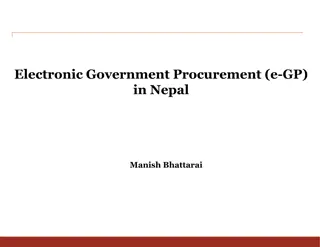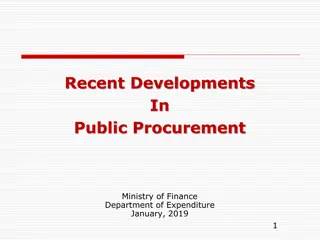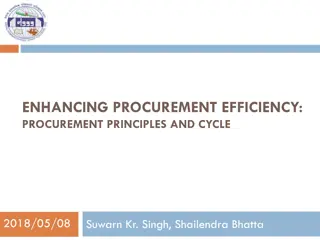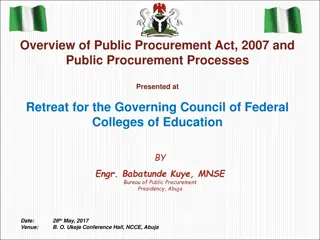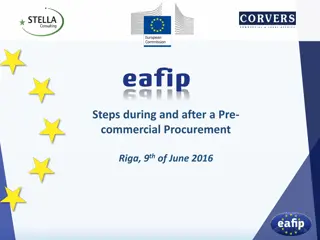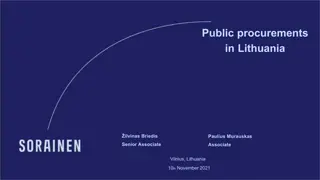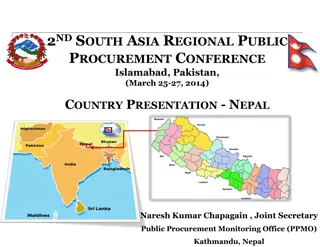Key Actions and Progress in Public Procurement Regional Conference
Key actions agreed upon at the Kathmandu Forum in 2011 and the progress status update by Chandra Man Shrestha from the Public Procurement Monitoring Office, Nepal. The discussion focuses on common platform initiatives, capacity building, professionalization efforts, procurement tools, standards, processes, and the way forward for the regional conference.
Download Presentation

Please find below an Image/Link to download the presentation.
The content on the website is provided AS IS for your information and personal use only. It may not be sold, licensed, or shared on other websites without obtaining consent from the author.If you encounter any issues during the download, it is possible that the publisher has removed the file from their server.
You are allowed to download the files provided on this website for personal or commercial use, subject to the condition that they are used lawfully. All files are the property of their respective owners.
The content on the website is provided AS IS for your information and personal use only. It may not be sold, licensed, or shared on other websites without obtaining consent from the author.
E N D
Presentation Transcript
IGEES Irish Government Economic and Evaluation Service Spending Review 2022 An Analysis of Medical Workforce Supply Terence Hynes and Peter O Connor Department of Health March 2023
Spending Review 2022 Overview, Aims & Objectives Overview Medical workforce policy aims to train adequate numbers of medical doctors within Ireland and have sufficient numbers of medical specialists to provide a Consultant Delivered health service (Department of Health, 2003) (WHO, 2010). The number of doctors per capita in Ireland is similar to the average across the OECD. However, the proportion of foreign-trained doctors in Ireland stood at 40% in 2021 the fourth highest of member states. Furthermore, Ireland has a significantly below average number of specialist doctors. The number of specialists is the sixth lowest of OECD countries for which data is available. Aims and Objectives This Spending Review describes the medical education and training system in Ireland and examines some of challenges facing the health system in meeting the WHO-GCP commitment to reduce Ireland s reliance on the foreign educated medical workforce and in achieving a Consultant-Delivered health service. This paper develops a medical workforce supply model using systems dynamics modelling to understand the implications of substituting Non-EU/UK places in Irish medical schools for students from the EU or UK and how this may better align student intake with specialist training capacity in the health system 2 Rialtas na h ireann | Government of Ireland
Spending Review 2022 Key Policy Relevant Findings In the 2021/22 academic year there were 1,403 medical student places available in the Irish Higher Education System. This is the highest medical graduate output per capita amongst OECD countries, however due to the large proportion of Non-EU students (46%) and availability specialist training capacity many of these graduates do not progress on to become consultants in Ireland. The medical workforce supply model highlights that a long timeframe is required to increase medical education and training places. These places need to be carefully aligned to ensure the optimal pathway from student to consultant. Increased medical degree places necessary to redress the undersupply of Irish educated doctors require increased downstream capacity in specialist training programmes. For example, increasing undergraduate places in medicine by 100 requires an increase in internship places of 92 five years later and an increase in specialist training places (IST or GP training) of 75 approximately eight years later. These results are sensitive to modelling assumptions on student dropouts rates, attrition and emigration which may vary into the future. 3 Rialtas na h ireann | Government of Ireland
Spending Review 2022 Conclusions & Limitations This paper highlighted an historic undersupply of doctors within the medical education and training system which has contributed to a situation where there is an overreliance on foreign-educated doctors and relatively few Consultants when compared against our international peers. Because of the high proportion of Non-EU students educated here there is significant capacity to increase EU/UK student places within the educational system already. There are greater supply constraints within the postgraduate training system, though growth in capacity in recent years has been high. Even with large-scale increases in medical degree student intake in the short term, reducing Ireland s reliance on foreign educated medical workforce will be a long-term endeavour. This analysis looked at a range of scenarios which increased EU/UK medical student and specialist training intake, however does not define the optimal student intake. Nor does it estimate the potential for increasing postgraduate training capacity, for which the main constraint is the availability of Consultants. Further work is underway to identify the optimal medical student intake in Ireland, in particular estimating the total demand for doctors across the whole health system and the supply-side capacity required to meet this demand. 4 Rialtas na h ireann | Government of Ireland
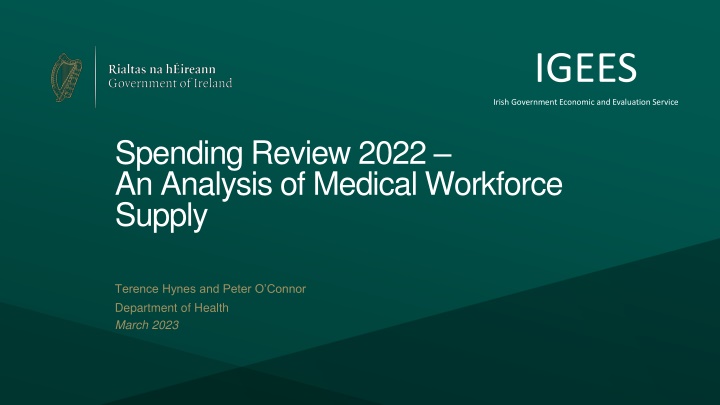

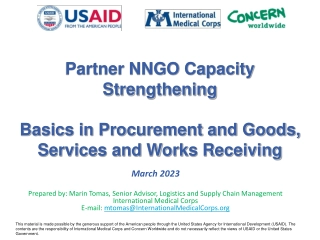
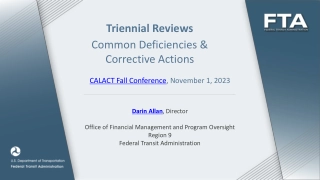
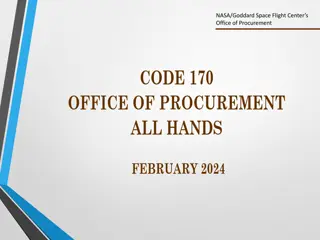
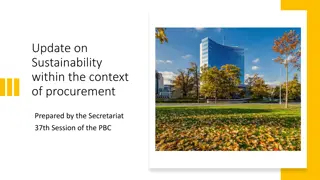


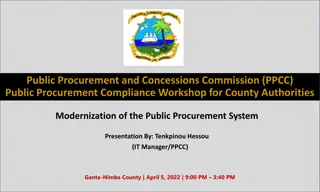
![Comprehensive Overview of Corruption Watch Submission on Public Procurement Bill [B18B-2023]](/thumb/138344/comprehensive-overview-of-corruption-watch-submission-on-public-procurement-bill-b18b-2023.jpg)

